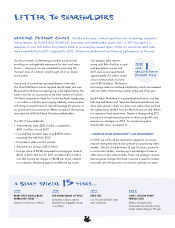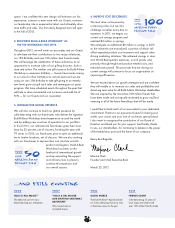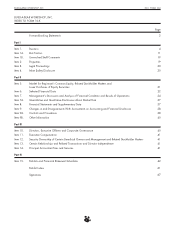Build-A-Bear Workshop 2011 Annual Report Download - page 16
Download and view the complete annual report
Please find page 16 of the 2011 Build-A-Bear Workshop annual report below. You can navigate through the pages in the report by either clicking on the pages listed below, or by using the keyword search tool below to find specific information within the annual report.
BUILD-A-BEAR WORKSHOP, INC. 2011 FORM 10-K
INDUSTRY AND GUEST DEMOGRAPHICS
While Build-A-Bear Workshop offers consumers an interactive
and personalized experience, our tangible products are
stuffed animals, including our flagship product, the teddy
bear, a widely adored icon for over 100 years. According to
data published by the Toy Industry Association and The NPD
Group, sales of the traditional toy market were $21.2 billion
in the United States (excluding video games) in 2011 with
plush and doll sales having a combined 18.7% share of the
traditional toy market. According to further data provided by
The NPD Group, worldwide toy sales topped $83.3 billion
dollars in 2010.
Our guests are diverse, spanning broad age ranges and
socio-economic categories. Major guest segments include
families with children, primarily ages three to twelve,
grandparents, aunts and uncles, teen girls who occasionally
bring along their boyfriends, and child-centric organizations
looking for interactive entertainment options such as scouting
organizations and schools. Based on information compiled
from our guest database for 2011, the average age of the
recipient of our stuffed animals at the time of purchase is nine
years old and children aged one to fourteen are the recipients
of approximately 80% of our stuffed animals.
According to the estimates by the United States Census
Bureau, in 2009 there were over 62 million children age 14
and under in the United States. The size of this population
group is projected to remain relatively stable over the next
decade. Industry sources estimate direct spending by children
in the United States at over $50 billion annually and that
parents and family members spend an additional $170 billion
annually on children. In addition, children influence billions of
dollars in other family spending.
EMPLOYEES AND TRAINING
In January 2012, we were recognized by Fortune magazine
for the fourth consecutive year as one of the 100 Best
Companies to Work For. We believe that this honor is the
result of our commitment to providing a great experience for
our diverse team of associates as well as our guests. We have
a distinctive culture that we believe encourages contribution
and collaboration. We take great pride in our culture and feel
it is critical in encouraging creativity, communication, and
strong store performance. All store managers receive
comprehensive training through our Bear University program,
which is designed to promote a friendly and personable
environment in our stores and a consistent experience across
our stores.
We extensively train our associates on the bear-building
process and the guest experience. In fiscal 2011, we hired
approximately 3.5% of applicants for store manager
positions. We focus on employing and retaining people who
are friendly and committed to guest service. Our high
employee retention rates contribute to the consistency and
quality of the guest experience. Our store teams are evaluated
and compensated not only on sales results but also the results
from our regular guest satisfaction surveys. Each store has a
recognition fund so that exceptional guest service can be
immediately recognized and rewarded. We are committed to
providing compensation structures that recognize individual
accomplishments as well as overall team success.
As of December 31, 2011, we employed approximately
1,000 full-time and 3,800 part-time employees. We divide
our store base into four geographic regions, with the
United Kingdom and Ireland representing one of those
regions. The regions are lead by our Chief Operations and
Financial Bear; our North American operations are led by our
Chief Workshop Bear – North America and there are three
Regional Workshop Managing Directors. Bearitory Leaders
are responsible for each of our 31 store districts, or
bearitories, consisting of on average, 11 stores. Historically,
our stores generally have had a full-time Chief Workshop
Manager, and three additional managers who are full-time or
part-time, depending upon the volume at the specific location,
in addition to part-time hourly Bear Builder®associates. The
number of part-time employees fluctuates depending on our
seasonal needs. In addition to the approximately
4,500 employees at our store locations, we employ
approximately 200 associates in general administrative
functions at our World Bearquarters in St. Louis, Missouri,
approximately 70 associates at our Bearhouse distribution
center in Groveport, Ohio, and approximately 30 associates
in our European Bearquarters in Windsor, England. We are
committed to innovation and invention and generally have
confidentiality agreements with our employees and
consultants. Store managers and Bearquarters associates pass
specific profile assessments. None of our employees are
represented by a labor union, and we believe our relationship
with our employees is good.
INTERNATIONAL FRANCHISES
In 2003, we began to expand Build-A-Bear Workshop stores
outside of the United States, opening company-owned stores
in Canada and our first franchised location in the
United Kingdom. As of December 31, 2011, there were
79 Build-A-Bear Workshop franchised stores located in the
following countries:
Germany . . . ............................. 17
Japan . . . ................................ 10
Australia . . . . ............................. 10
Denmark . . . . ............................. 9
Mexico . . . . . ............................. 8
South Africa .............................. 7
Thailand . . . . ............................. 5
Singapore . . ............................. 4
Gulf States(1) .............................. 4
Norway . . . . ............................. 3
Brazil . . . ................................ 1
Sweden . . . . ............................. 1
Total . . . . . ............................. 79
(1) Gulf States agreement includes Kuwait, Bahrain, Qatar, Oman and the
United Arab Emirates.
8
























